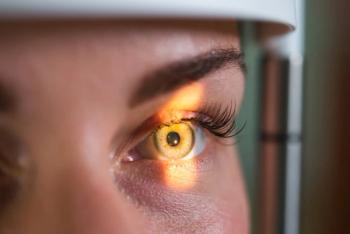
Optic nerve exam key to assessment
Clinical evaluation of the optic nerve head and retinal nerve fiber layer is essential for diagnosing glaucomatous damage and progression. A set of five rules outlines a systematic approach to the examination.
Key Points
"In glaucoma, structural damage may precede functional change, because we are currently able to measure it by up to 6 years. While various new imaging technologies are available for objective assessment of optic nerve head topography and the RNFL, for the time being, these instruments should be considered complementary, confirmatory tools," said Dr. Semes, professor of optometry, University of Alabama at Birmingham.
Known as the "five Rs," this approach describes rules for evaluating/observing the scleral ring, neuroretinal rim, the RNFL, region of parapapillary atrophy (PPA), and retinal and optic disc hemorrhages. The five Rs were originally developed and published by a group of ophthalmologists who are internationally recognized authorities on glaucoma. They are reviewed in an article by Murray Fingeret, OD, et al., in the November 2005 issue of Optometry.
"Although the images in the article are just two-dimensional photographs, they are in full color and provide a valuable reference," Dr. Semes said.
Scleral ring
The purpose of defining the scleral ring, which is the border of the lamina cribrosa, is to define the limits of the optic disc and its size. In performing this part of the exam, clinicians need to be aware that the size of the cup varies with the size of the disc in healthy eyes; that is, those with a small disc have a small cup, whereas eyes with a large disc have a large cup. Small cups can still be glaucomatous in eyes with small discs, however, he said.
Dr. Semes also said that evaluation of optic disc size can be difficult in eyes with high myopia because of the imprecise definition of the scleral ring and optic disc margins due to myopic stretching and oblique insertion of the optic disc.
Neuroretinal rim
Examination of the integrity and extent of the neuroretinal rim tissue focuses on evaluating neuroretinal rim size, shape, and color. The rim width is defined as the distance between the border of the disc and the position of blood vessel bending. The "ISNT rule" is a mnemonic aid that can help clinicians remember that in a normal eye, the rim width is thickest inferiorly, followed in descending order by the superior, nasal, and temporal regions. Other features to look for in addition to the presence of localized rim thinning are notching and pallor.
"A pale rim in the absence of cupping suggests glaucoma is not the cause of any optic neuropathy," Dr. Semes said.
Newsletter
Want more insights like this? Subscribe to Optometry Times and get clinical pearls and practice tips delivered straight to your inbox.









































